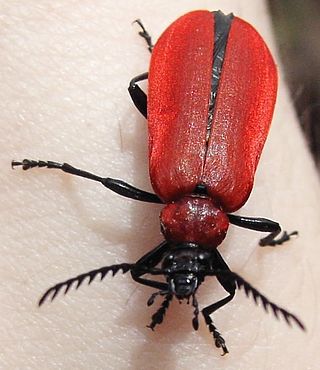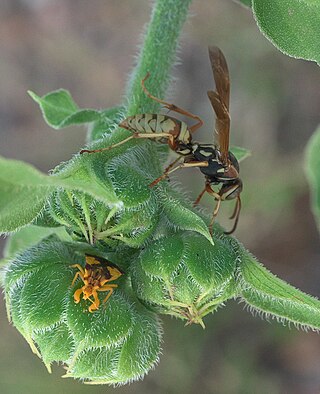
The dusky warbler is a leaf warbler which breeds in the east Palearctic. The genus name Phylloscopus is from Ancient Greek phullon, "leaf", and skopos, "seeker". The specific fuscatus is from Latin fuscus "dark".

The sooty tern is a seabird in the family Laridae. It is a bird of the tropical oceans, returning to land only to breed on islands throughout the equatorial zone.

Fire-coloured beetles is the common name for members of the tenebrionoid family Pyrochroidae. The family is found worldwide, and is most diverse at temperate latitudes. Adults measure 2–20 millimetres (0.079–0.787 in); larvae reach 35 millimetres (1.4 in). Larvae of Pyrochroinae are found associated with the bark of dead trees. They are probably mostly fungivorous, although they may become cannibalistic if too crowded.

The European paper wasp is one of the most common and well-known species of social wasps in the genus Polistes. Its diet is more diverse than those of most Polistes species—many genera of insects versus mainly caterpillars in other Polistes—giving it superior survivability compared to other wasp species during a shortage of resources.

The Ochteridae comprise a small family of insects. Eight genera with about 80 species have been described. They occur worldwide along the shore of various types of water and the greatest diversity is in tropical regions. They are "true bugs", being members of the order Hemiptera, and are in the suborder Heteroptera. Ochteridae commonly are known as the velvety shore bugs. They resemble the Saldidae shore bugs and have lengths ranging from 4.5 to 9 mm (0.18–0.35 in).

Eumorpha vitis, known as the vine sphinx, is a moth of the family Sphingidae.

The pearly-eyed thrasher is a bird in the thrasher family Mimidae. It is found on many Caribbean islands, from the Bahamas in the north to the Grenadines in the south, with an isolated subspecies on Bonaire.
Handleyomys fuscatus, also known as the dusky-footed Handley's mouse or dusky-footed montane mouse, is a species of rodent in the tribe Oryzomyini of family Cricetidae. It was previously placed in the genus Aepeomys, but it is closely similar to Handleyomys intectus, and accordingly both species were placed in the new genus Handleyomys in 2002. It is found only in Colombia.

The dusky slender opossum is a species of opossum in the family Didelphidae. It is found in Colombia, Trinidad and Tobago, and Venezuela. It is threatened by habitat loss.

Baetis is a genus of mayflies of the family Baetidae, known as the blue-winged olive to anglers. There are at least 150 described species in Baetis. They are distributed worldwide, with the most variety in North America and northern Europe.

Tympanotonos fuscatus, the West African mud creeper, is a species of snail living in brackish water, a gastropod mollusk in the family Potamididae.

Polistes fuscatus, whose common name is the dark or northern paper wasp, is widely found in eastern North America, from southern Canada through the southern United States. It often nests around human development. However, it greatly prefers areas in which wood is readily available for use as nest material, therefore they are also found near and in woodlands and savannas. P. fuscatus is a social wasp that is part of a complex society based around a single dominant foundress along with other cofoundresses and a dominance hierarchy.

Philonicus albiceps is a species of 'robber fly' belonging to the family Asilidae. It is a Palearctic species with a limited distribution in Europe

Polistes aurifer, the golden paper wasp, is a species of paper wasp in the genus Polistes of the family Vespidae. It occurs in the western part of North America, from southern Canada through the United States to northern Mexico.
Sylvicola fuscatus is a species of wood gnats, insects in the family Anisopodidae.
Stenolophus fuscatus is a species of ground beetle in the family Carabidae. It is found in North America.
Philonicus plebeius is a species of robber flies in the family Asilidae.

Philonicus is a genus of robber flies in the family Asilidae. There are at least 20 described species in Philonicus.
Cryptorhynchus fuscatus is a species of hidden snout weevil in the beetle family Curculionidae. It is found in North America.

Meloetyphlus fuscatus, the blind blister beetle, is a species of blister beetle in the family Meloidae found in Central and South America. They are kleptoparasites of orchid bees and are entirely blind as adults. Unique among meloids, females do not lay their eggs near flowers, but rather within their hosts' nests.














